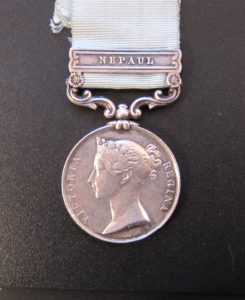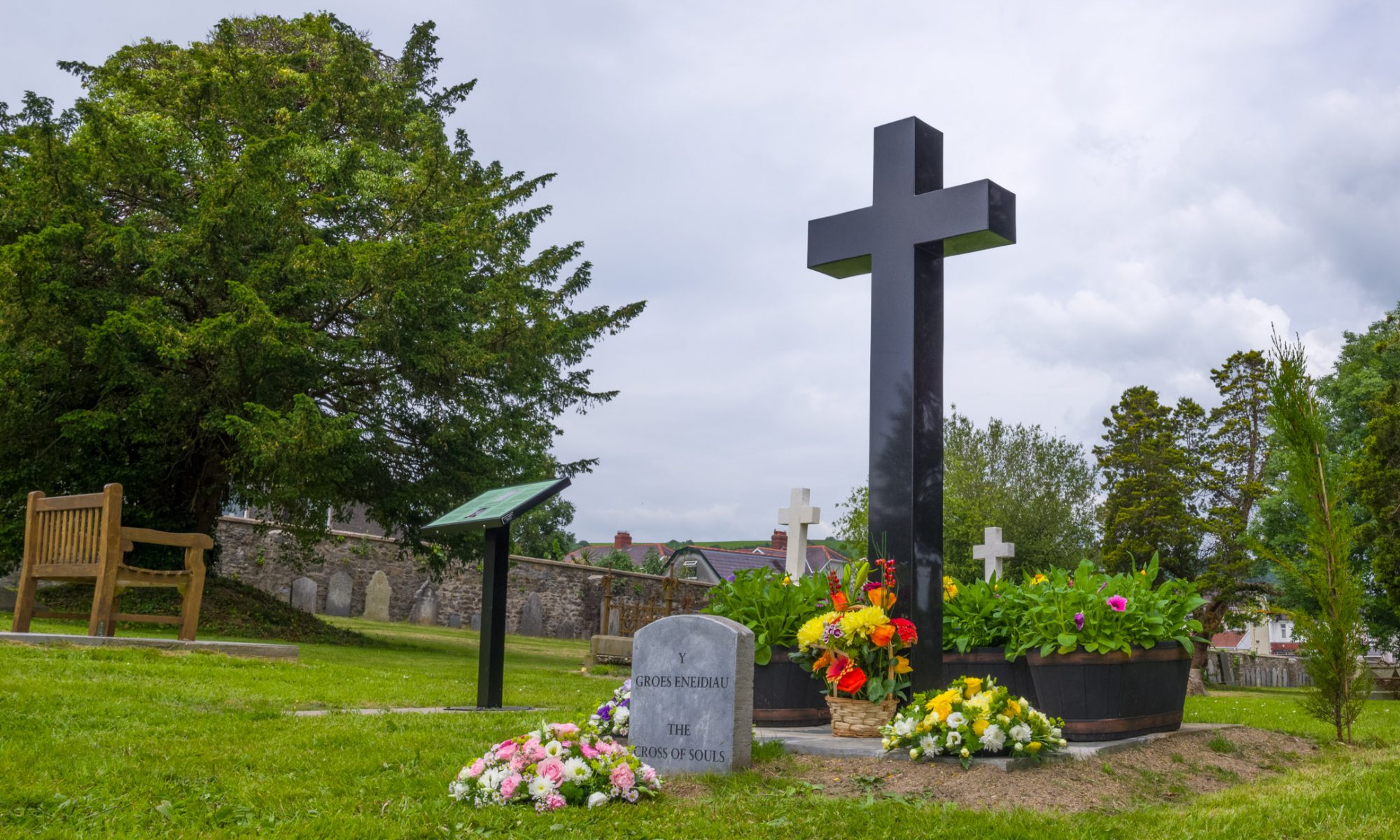 Job Cook 1829 – 1897 & Henry Davies (father in law) 1789 -1869
Job Cook 1829 – 1897 & Henry Davies (father in law) 1789 -1869
In the 1977 survey of memorials at St David’s there is a description that mentions a “tall obelisk” with the inscription JOB COOK, BOGGABILLA N.S.W. OCT 15 1897.
When the survey was carried out it recorded the inscriptions of what could be read and identified, but the survey is incomplete and many names and details went unrecorded. What then was this unusual inscription all about and where is Boggabilla and why an inscription on a grave of a person from Australia…well here is the story (so far) which makes fascinating reading.
GOONDIWINDI and BOGGABILLA are names more reminiscent of Tolkien’s Lord of the Rings than having a connection with Carmarthen and St David’s Cemetery. On Christmas Day in 1853 Job Cook aged 24 and Johanna Davies aged 34 were married at St David’s Church. Both lived in Bridge Street Carmarthen. Job’s father Charles being described as a labourer and Joanna’s father Henry** was a Draper who had his premises at 9 Bridge Street next to the Horse and Jockey Public House (176 Public Houses in Carmarthen at that time)
Job was a steerage passenger on board the ship “Closeburn” which departed Glasgow Scotland 6th June 1888 arriving at Moreton Bay (Brisbane) on 28th September 1888. Job then went to live with his brother Robert and his wife Catherine on their property “Oakhurst” which was about 25 miles south east of Goondiwindi in Queensland and 20 miles from Boggabilla NSW. He worked for Robert as a stockman until he was accidently killed when he was thrown off a horse on 15th October 1897 aged 68.
He is buried in an unmarked grave in a small cemetery in Boggabilla which even today has only 700 inhabitants and is primarily an indigenous Aboriginal settlement.
Why Job left for Australia is not known, but rather interestingly there are many descendants of the Cook family still living there and are well respected in their local community….as for Johanna she died in Burnley, Lancashire in March 1910 aged 93, and very unusually for the time, her body was transported back to her beloved Carmarthen by rail and on March 22nd she was buried in St David’s Cemetery with her parents Henry and Margaret. Despite the premature death of her husband Job some thirteen years earlier on the other side of the world she obviously never lost her love of him and the fact that his name and place of burial appears on the family grave in St David’s is testimony to the strong bond that existed between them……….
As always when carrying out research of this type it sometimes throws up the really “unexpected” and this story is no exception. HENRY DAVIES, Johanna’s father mentioned above had himself a remarkable life. What is not known to the “outside world” is that Henry (5ft 8ins with grey eyes and a dark complexion) enlisted as a young teenager in the 53rd Regiment of Foot in 1807 and after seven years with the colours found himself fighting in the foothills of Nepal in 1814. He was severely injured in the fighting and was medically discharged on 3rd November 1814, yet it was not until 37 years later – on the 14th October 1851 that he applied successfully for an army pension for which he was awarded sixpence a day. Also the same year, in 1851 the Honourable East India Company with approval from Queen Victoria approved the issue of the Army of India Medal to be issued to all of those who fought (and survived) in the campaign of 1814. Out of 600 men of the 53rd Regiment of Foot only 17 medals were issued, as most had died in the intervening years and many had not applied for the medal to which they were entitled to. Henry himself despite applying for an army pension the same year in 1851, also never applied for the medal to which he was entitled. Henry died on March 5th 1869 aged 86 and was buried four days later at St David’s without fanfare or fuss. However, in memory of his great and unsung heroic achievements I have purchased a copy of the medal to which he would have received and this will be used to further promote the rich heritage and history of St David’s.
HENRY DAVIES (53rd Regiment of Foot) from CARMARTHEN, and his part in the fighting of the Siege of Nepal (Kalunga) in 1814
Below is a small extract of the fighting that took place in which Henry Davies was severely wounded by gunshot in November 1814, but who survived and returned home to Carmarthen. He died in March 1869 aged 86 years old and is buried in St David’s cemetery with his family.
At 10:30 AM on October 31st 1814 three straggling companies of the Fifty-Third Regiment arrived, and Gillespie promptly led them in an attempted to salvage the deteriorating situation. A dragoon had noticed a small opening in the northwest wall of the fort. Gillespie, Mawby, Carpenter, and Ludlow met and decided to move toward the opening and to attempt to force their way through. The smoke from the burning huts provided a screen for their movement. Balbhadra Kunwar was well aware of the gap, and beforehand barricaded it with stones and logs and placed single cannon at its entrance.
Gillespie ordered a six-pound horse artillery gun to be brought up and fired into the entrance. He had hoped it would wreck the Nepalese cannon and barricade in order for his party storm through. Once he was satisfied it was demolished, he ordered Ludlow to personally take a storming party through the opening. When within point blank range, grapeshot was unleashed into them by the Nepalese cannon crew. Women and children began to hurl stones at them from atop the palisade wall. Ludlow himself was hit the thigh by a large stone. The combination of these factors led them to waver and fall back.
The Nepalese defenders once again left their interior defenses and crashed into the demoralized attackers. They were able to overrun the six-pound horse artillery gun. Ludlow attempted to lead a counter attack, but only four men were willing to follow him amid his desperate pleas. The men had lost their vigor against an enemy that displayed such admirable fortitude. One soldier by the name of John Ship recalled he “never saw more steadiness or bravery exhibited in my life. Run they would not and of death they seemed to have no fear though their comrades were falling thick around them, for we were so near that every shot told.”
Infuriated at this repulse, Gillespie personally led the men of the Fifty-Third in a counterattack within twenty-five yards of the fortress under a sweeping fire of arrows, matchlocks and grape shot. Just before 11:15 AM, Gillespie turned to a horse gunner and fellow Ulsterman, and roared, “Now Charles. Now for the honor of Down.” A Nepali sharpshooter took advantage of the exposed Gillespie frantically wielding his sword in the air and fired an aimed shot that penetrated his heart, instantly killing him. The death of General Gillespie caused the assault to come to a halt.
Mawby assumed command and immediately ordered the attack called off. The attackers streamed to the rear in the face of the bold Nepalese defenders. Campbell held his column still as he heard the fire growing more intense, and finally relented and moved his column forward. He arrived too late as Ludlow was already overseeing the withdrawal. The battle was over. The column suffered heavily with the loss of 35 killed and 228 wounded. The body of Gillespie was retrieved by his men and was preserved in alcohol mockingly ‘pickled’ until it arrived in Meerut for burial.
Nearly a month, later on, November 24, the attack was renewed by Mawby. It was again repulsed with heavy losses. After these two failed attempts to capture the fort, the water supply was cut off placed under siege. After 29 days, the Nepalese defenders, only 68 remaining of the original 600, attempted a risky breakout. Balbhadra Kunwar and the survivors were able to fight their way through the besieging force and escape, never formally surrendering. The fort was completely dismantled and burnt to the ground, in retaliation for the staggering 31 officers and 750 men lost.
The campaign to defeat the Nepalese would drag on for 18 long months, finally ending in March of 1816. The ferocity and courage that the Nepalese defenders exhibited in the battle of Kalunga, and in the war, captivated the British officers and soldiers who were tasked with conquering this rugged region. James Baillie Fraser praised their effort stating that they fought despite their “hopelessness of relief” and fought with “unsubdued courage.” As a result of their prowess in the war against the East India Company, thousands of Nepalese hill men were recruited in 1815 by the British to serve in their Indian Army. They became a pillar of the British Indian Army up until the independence of India in 1947.
Even though eventually victorious through the later efforts of David Ochterlony, the war was a costly endeavor for the East India Company. Pemble stated that it had failed to enhance British trade in the way Hastings had hoped. The repulse at Kalunga was a defining moment in British India. A ragtag collection of men, women, and children had shown they could defeat a professionally trained army of the British East India Company.
It was not until the 14th October 1851 – some 37 years later that Henry applied for and received a disablement pension of sixpence a day from the Army for the wounds he received in 1814. Though he was entitled to the Army of India Medal for his service in Nepal he never applied for it. The medal itself was not approved until 1851 and the medal roll confirms that only seventeen members of the Regiment ever received it.

